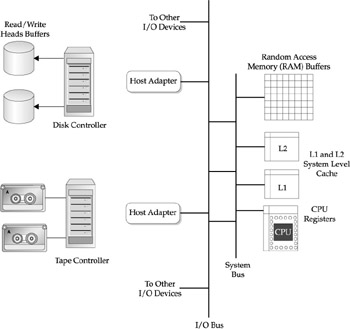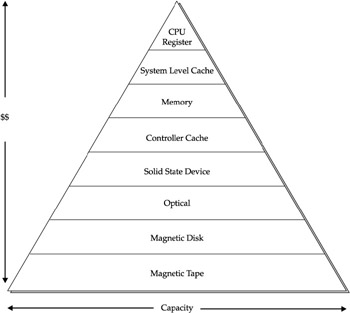Chapter 5: Storage Architectures
| |
In Part II, we will review the basic elements and devices that make up computer storage. Although the level of information will be summary in detail, these are the components you are likely to encounter in dealing with changes to storage infrastructures brought on by storage networking. In many instances, it will be these devices, their performance, and logical configurations that are overlooked as they extend beyond the bounds of typical storage systems. As such, they are critical factors when addressing issues affecting storage performance. More importantly are the effects these elements, devices, and components will have when integrating storage networking into your infrastructure.
In Part I, the decoupling of storage devices caused us to reevaluate the necessary functions to develop an optimum data highway to the server. This quickly becomes a complex task as some storage devices become remotely connected, such as disks and disk controllers. With the introduction of networking and switching technologies, their capabilities and functionality begins to change and their operation with other components that transport data to and from the CPU can become compromised. However, understanding how data travels in traditional direct connect configurations can be complex in and of itself. It is imperative that these situations are understood both in context with data center practices and storage device principles of operations, prior to an in-depth discussion of storage networking.
Storage Elements
Storage can be defined as the components and locations where data is staged before and after it is accessed by the computer's central processing unit (CPU). The components that make up specific storage devices in today's computers are multifold, however they still have one main objective. They move data in the most efficient manner in and out of the CPU to process application program instructions.
The storage locations are multifunctional in usage and multidimensional in capacity. Figure 5-1 depicts the locations where data is stored for action by the CPU. Although you wouldn't expect to classify some of these locations as storage, their purpose is to provide a location for data, albeit temporary in many cases, before or after operation by the CPU. A parochial view of hard disk or archival storage does not take into account all the components involved in transporting data to and from processing objectives. By gaining a complete understanding of all storage locations, we systemically address all the elements that affect the supply of data to the CPU and therefore the system's potential, improving application program performance and storage device optimization.

Figure 5-1: The diversity of storage locations
Storage locations are characterized by their volatility and temporary nature. This is demonstrated through their effect on the data stored within each storage component. Data stored on hard magnetic disk, tape, or optical is considered non-volatile and therefore stores data permanently in context with its logical form-for example, a customer file, binary program, or an image. In contrast to these devices, there are the components such as system level cache, controller cache, memory buffers, and disk read/write cache-buffers that are highly volatile. These components are used for only temporary locations and are staged in physical locations in increasing proximity to the CPU. The nearest component to the CPU is the fastest , and thus it is more volatile with the data it transports.
Component speed and CPU proximity drive the balance between slower and faster elements that make up this store and forward like architecture. As we saw in Figure 5-1, many of the faster components are necessary to account for the slower performance of others. Moving data into position to be accessible by the CPU requires staging areas such as system level cache so that CPU processing does not have to wait for a slow mechanical device such as a disk drive to transport a copy of its data to the CPU. The same can be said for the reverse operations; once the CPU has completed its instructions, it can use a staging area such as system level cache so it does not have to wait for the write operation to be complete out to the slower disk drive or be forced to wait the time it takes to flush and rewrite the buffer space in memory.
The corollary, or trade-off to this condition, is the economics of speed and capacity to price. Consequently, the faster the component, the higher the price for parking data. An example of the dynamics of price difference can be found in the comparison of solid-state disks (SSD) versus magnetic disks. Each can perform similar functions, however the SSD made up of logic circuits from silicon wafers in the form of a chip is much more expensive than its counterpart , the magnetic disk, which operates using mechanical devices and electronics on magnetic media. Although each stores data, the SSD device, operating electronically within a chip, is exponentially faster than the mechanical operation of the magnetic disk. Although there are many examples within the storage hierarchy, the point is the following: it becomes economically prohibitive to store large capacities on higher performing components.
Although it's possible to load small databases into the main memory of large machines, you still have the problem of keeping the permanent copy up to date in case of hardware or software error or system termination. Therefore, we find the additional corollary to speed and capacity is reliability. As system outages occur, the temporary storage locations are flushed or cleared, at which point the potential for data loss is imminent, and for most users, unacceptable. Therefore, recovery of the data that was contained within these storage locations has to be taken into account. This becomes especially challenging as we discover that some storage components are accessed remotely as networks are introduced into the connectivity scheme. As a result, many components (such as controller caches) become shared. We will examine in more detail the capability to recover various storage elements within these conditions later in Part IV, and how they will become critical design factors in Part III, regarding both NAS and SANs.
Data Storage Hierarchy
The benefits of understanding all the elements of storage is that it begins to form a foundation for working with data volatility and the effective use of the multifunctional components that data must traverse to satisfy the application. As previously stated, the effect these components have on system and application performance, such as controller cache and a disk's average access response time performance can be the difference between effective utilization strategies and overcompensation for device inefficiencies . With this knowledge, the traditional data storage hierarchy (as shown in Figure 5-2) takes on new and challenging characteristics.

Figure 5-2: The data storage hierarchy
The data storage hierarchy extends from the CPU to the storage media. The following highlights some of the major components that make up this data highway:
-
CPU Registers The component of the central processing unit that stores program instructions and intermediate, prestage, and post operations data.
-
First Level L1 Cache The component that provides a data staging area closest to the central processing unit; employed for prestaging and post-staging data used by the CPU instructions.
-
Second Level L2 Cache The component that provides additional data staging areas to the CPU, but which are further away and which act as supplements to the L1 cache component.
-
Memory Buffers Locations within the memory where data is staged for pre and post-processing by CPU instructions.
-
Direct Memory Access (DMA) A component that allows peripherals to transfer data directly into and out of computer memory, bypassing processor activities.
-
Host Adapter Cache/Buffer The component within a device adapter that provides staging for data that is being read or written to disk storage components.
-
Hard Disk Controller Cache/Buffer An additional component that provides another staging area for read data that is waiting to move into the memory or L2 or L1 cache, or waiting to be written into locations within the disk storage media.
-
Hard Disk The component that provides a permanent location for system and application data slated to be stored for access by system and applications programs.
-
Archival Storage The locations where data is stored for later use. This may be for archiving historical data no longer needed for business or systems applications, or for copies of business or systems data needed for recovery operations in the event of system outages or other computer disasters.
| |
EAN: 2147483647
Pages: 192